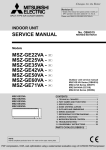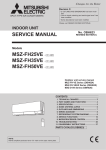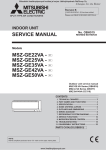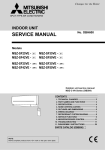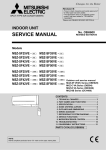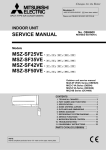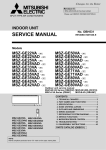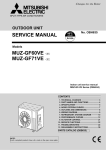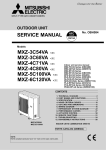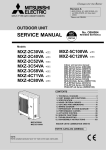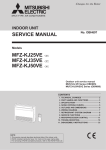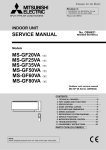Download Mitsubishi Electric MSZ-GF71VE Service manual
Transcript
SPLIT-TYPE AIR CONDITIONERS INDOOR UNIT SERVICE MANUAL No. OBH634 Models MSZ-GF60VE MSZ-GF71VE - E1 - E1 Outdoor unit service manual MUZ-GF·VE Series (OBH635) MXZ-D·VA Series (OBH626) MXZ-6C122VA (OBH584) CONTENTS 1. TECHNICAL CHANGES ··································· 3 2. PART NAMES AND FUNCTIONS ····················· 4 3. SPECIFICATION ················································ 5 4. NOISE CRITERIA CURVES ······························ 6 5. OUTLINES AND DIMENSIONS ························ 7 6. WIRING DIAGRAM············································ 8 7. REFRIGERANT SYSTEM DIAGRAM ··············· 8 8. SERVICE FUNCTIONS ····································· 9 9. MICROPROCESSOR CONTROL ····················11 10. TROUBLESHOOTING ····································· 18 11. DISASSEMBLY INSTRUCTIONS ···················· 32 PARTS CATALOG (OBB634) NOTE: RoHS compliant products have <G> mark on the spec name plate. Use the specified refrigerant only Never use any refrigerant other than that specified. Doing so may cause a burst, an explosion, or fire when the unit is being used, serviced, or disposed of. Correct refrigerant is specified in the manuals and on the spec labels provided with our products. We will not be held responsible for mechanical failure, system malfunction, unit breakdown or accidents caused by failure to follow the instructions. <Preparation before the repair service> Prepare the proper tools. Prepare the proper protectors. Provide adequate ventilation. After stopping the operation of the air conditioner, turn off the power-supply breaker and remove the power plug. Discharge the capacitor before the work involving the electric parts. <Precautions during the repair service> Do not perform the work involving the electric parts with wet hands. Do not pour water into the electric parts. Do not touch the refrigerant. Do not touch the hot or cold areas in the refrigeration cycle. When the repair or the inspection of the circuit needs to be done without turning off the power, exercise great caution not to touch the live parts. OBH634 2 1 TECHNICAL CHANGES MSZ-GF60VE MSZ-GF71VE - E1 E1 1. New model These models are compatible with the outdoor units with low standby power control. Connecting these models to the MUZ-GF·VE-series outdoor units enables the low standby power control. Refer to the technical guide (OBT17) about the low standby power control. These models may be connected to the MUZ-GF·VE series after once connected to the MXZ series and operated, for example because of relocation. In that case, the MUZ-GF·VE series outdoor units will not operate without taking a step. Follow the procedure "Deleting the memorized abnormal condition" described in 10-2.1. OBH634 3 2 PART NAMES AND FUNCTIONS MSZ-GF60VE MSZ-GF71VE Front panel Air filter (Nano platinum filter) Air cleaning filter (Electrostatic anti-allergy enzyme filter, option) Air inlet Air outlet Fan guard Remote controller Fan Horizontal vane Heat exchanger Vertical vane Display section Operation indicator lamp Emergency operation switch (E. O. SW) Remote control receiving section ACCESSORIES Model MSZ-GF60VE MSZ-GF71VE Installation plate Installation plate fixing screw 4 × 25 mm Remote controller holder Fixing screw for 3.5 × 16 mm (Black) Battery (AAA) for remote controller Wireless remote controller Felt tape (For left or left-rear piping) 1 7 1 2 2 1 1 OBH634 4 3 SPECIFICATION Indoor model MSZ-GF60VE 0.43 0.53 58 58 0.51 0.51 RC0J56-AF 0.51 0.51 1100 × 325 × 238 16 5 1,242 1,164 1,098 936 804 678 588 1,068 924 798 690 582 1,242 1,164 1,098 936 (882 2) 804 678 588 1,068 924 798 690 612 52 53 49 45 41 37 29 30 52 49 45 41 37 Heating Fan speed Cooling Heating Sound level Cooling Heating Airflow Cooling Electrical data 48 62 0.43 0.53 Special remarks MSZ-GF71VE Single phase 230 V, 50 Hz Fan motor Power supply Cooling Power input W 1 Heating Cooling Running A current 1 Heating Model Cooling A Current 1 Heating Dimensions W × H × D mm Weight kg Air direction Super High + LONG + POWERFUL Super High High Med. m3/h Low Silent Super High + LONG + POWERFUL Super High High Med. m3/h Low Silent Super High + LONG + POWERFUL Super High High Med. dB(A) Low Silent Super High + LONG + POWERFUL Super High High Med. dB(A) Low Silent Super High + LONG + POWERFUL Super High High Med. rpm Low Silent Super High + LONG + POWERFUL Super High High Med. rpm Low Silent Fan speed regulator Remote controller model 29 30 1,280 1,300 1,090 960 850 740 660 1,140 1,010 900 800 700 1,280 1,300 1,090 960 (910 2) 850 740 660 1,140 1,010 900 800 730 5 SG12D NOTE: Test conditions are based on ISO 5151. Cooling: Indoor Dry-bulb temperature 27°C Wet-bulb temperature Outdoor Dry-bulb temperature 35°C Heating: Indoor Dry-bulb temperature 20°C Outdoor Dry-bulb temperature 7°C Wet-bulb temperature 1 Measured under rated operating frequency. 2 For multi system. OBH634 5 19°C 6°C Specifications and rated conditions of main electric parts (F11) T3.15AL250V Horizontal vane motor (MV1) 12 VDC Vertical vane motor (MV2) 12 VDC (NR11) S10K300E3K1 (ERZV14D471) Fuse Varistor Terminal block (TB) Relay (X1) 4 3P NOISE CRITERIA CURVES MSZ-GF60VE MSZ-GF71VE FAN SPEED FUNCTION Super High SPL(dB(A)) COOLING 49 HEATING 49 LINE FAN SPEED FUNCTION Super High 80 70 NC-70 60 NC-60 50 NC-50 40 NC-40 30 NC-30 20 NC-20 NC-10 10 49 HEATING 49 LINE 90 OCTAVE BAND SOUND PRESSURE LEVEL, dB re 0.0002 MICRO BAR OCTAVE BAND SOUND PRESSURE LEVEL, dB re 0.0002 MICRO BAR 90 SPL(dB(A)) COOLING 63 125 250 500 1000 2000 4000 80 70 60 NC-60 50 NC-50 40 NC-40 30 NC-30 20 63 125 BAND CENTER FREQUENCIES, Hz Test conditions Cooling: Dry-bulb temperature 27°C Wet-bulb temperature 19°C Heating: Dry-bulb temperature 20°C 250 500 1000 2000 4000 BAND CENTER FREQUENCIES, Hz INDOOR UNIT WALL 1m 0.8m MICROPHONE OBH634 NC-20 NC-10 10 8000 NC-70 6 8000 5 OUTLINES AND DIMENSIONS MSZ-GF60VE MSZ-GF71VE Unit: mm 11×26 Oblong hole 129 Installation plate 1100 1090 225 11×20 Oblong hole 225 21.5 110 Indoor unit 238 199.5 500.5 3 199.5 49.5 439.5 Air in Installation plate 45 44 281 239.5 238.5 258.5 280 5 110.5 Wall hole Ø75 325 210 5 76 843 100 63 181 65 ( 70° ) 18 Air out Drain hose 63 63 30 65 Piping MSZ-GF60VE 193 60 125 160 184 3 65 12 67 Piping 65 Insulation Liquid line Gas line Drain hose Ø50 O.D Ø9.52 - 0.5m (Flared connection Ø6.35) Ø12 - 0.43m (Flared connection Ø15.88) Inslation Ø28 Connected part Ø16 O.D Piping MSZ-GF71VE OBH634 7 Insulation Liquid line Gas line Drain hose Ø50 O.D Ø9.52 - 0.5m (Flared connection Ø9.52) Ø12 - 0.43m (Flared connection Ø15.88) Inslation Ø28 Connected part Ø16 O.D 6 WIRING DIAGRAM MSZ-GF60VE MSZ-GF71VE 7 REFRIGERANT SYSTEM DIAGRAM MSZ-GF60VE MSZ-GF71VE Unit: mm Refrigerant pipe ø15.88 (with heat insulator) Indoor heat exchanger Indoor coil thermistor RT12 (main) Flared connection Indoor coil thermistor RT13 (sub) Room temperature thermistor RT11 Flared connection Refrigerant pipe ø6.35 (MSZ-GF60VE) ø9.52 (MSZ-GF71VE) (with heat insulator) Refrigerant flow in cooling Refrigerant flow in heating OBH634 8 8 SERVICE FUNCTIONS MSZ-GF60VE MSZ-GF71VE 8-1. TIMER SHORT MODE For service, the following set time can be shortened by short circuit of JPG and JPS on the electronic control P.C. board. (Refer to 10-7.1.) • The set time for the ON/OFF timer can be reduced to 1 second for each minute. • After the breaker is turned on, the time for starting the compressor, which normally takes 3 minutes, can be reduced to 1 minute. Restarting the compressor, which takes 3 minutes, cannot be reduced. 8-2. P.C. BOARD MODIFICATION FOR INDIVIDUAL OPERATION A maximum of 4 indoor units with wireless remote controllers can be used in a room. In this case, to operate each indoor unit individually by each remote controller, P.C. boards of remote controller must be modified according to the number of the indoor unit. How to modify the remote controller P.C. board Remove batteries before modification. The board has a print as shown below: MSZ-GF60VE MSZ-GF71VE J1 J2 NOTE: For modification, take out the batteries and press the OPERATE/STOP (ON/ OFF) button 2 or 3 times at first. After modification, put back the batteries then press the RESET button. The P.C. board has the print “J1” and “J2”. Solder “J1” and “J2” according to the number of indoor unit as shown in Table 1. After modification, press the RESET button. Table 1 1 unit operation 2 units operation 3 units operation 4 units operation No. 1 unit No modification Same as at left Same as at left Same as at left No. 2 unit — Solder J1 Same as at left Same as at left No. 3 unit — — Solder J2 Same as at left No. 4 unit — — — Solder both J1 and J2 How to set the remote controller exclusively for particular indoor unit After you turn the breaker ON, the first remote controller that sends the signal to the indoor unit will be regarded as the remote controller for the indoor unit. The indoor unit will only accept the signal from the remote controller that has been assigned to the indoor unit once they are set. The setting will be cancelled if the breaker is turned OFF, or the power supply is shut down. Please conduct the above setting once again after the power has restored. OBH634 9 8-3. AUTO RESTART FUNCTION When the indoor unit is controlled with the remote controller, the operation mode, the set temperature, and the fan speed are memorized by the indoor electronic control P.C. board. “AUTO RESTART FUNCTION” automatically starts operation in the same mode just before the shutoff of the main power. Operation If the main power has been cut, the operation settings remain. After the power is restored, the unit restarts automatically according to the memory. (However, it takes at least 3 minutes for the compressor to start running.) How to disable “AUTO RESTART FUNCTION” Turn off the main power for the unit. Cut the jumper wire to JR77 on the indoor electronic control P.C. board. (Refer to 10-7.1.) CN10A CN151 CN152 CN111 CN112 JR77 Indoor electronic control P.C. board NOTE: • The operation settings are memorized when 10 seconds have passed after the indoor unit was operated with the remote controller. • If main power is turned OFF or a power failure occurs while AUTO START/STOP timer is active, the timer setting is cancelled. • If the unit has been off with the remote controller before power failure, the auto restart function does not work as the power button of the remote controller is OFF. • To prevent breaker OFF due to the rush of starting current, systematize other home appliance not to turn ON at the same time. • When some air conditioners are connected to the same supply system, if they are operated before power failure, the starting current of all the compressors may flow simultaneously at restart. Therefore, the special counter-measures are required to prevent the main voltage-drop or the rush of the starting current by adding to the system that allows the units to start one by one. OBH634 10 9 MICROPROCESSOR CONTROL MSZ-GF60VE MSZ-GF71VE WIRELESS REMOTE CONTROLLER Signal transmitting section LONG button WIDE VANE CONTROL button OPERATION SELECT button Operation display section FAN SPEED CONTROL button ECONO COOL button VANE CONTROL button TIME, TIMER set buttons FORWARD button BACKWARD button POWERFUL button i-save button Temperature buttons WEEKLY TIMER set button OPERATE/STOP (ON/OFF) button RESET button CLOCK SET button Indication of remote controller model is on back NOTE: Last setting will be stored after the unit is turned OFF with the remote controller. Indoor unit receives the signal of the remote controller with beeps. INDOOR UNIT DISPLAY SECTION Operation Indicator lamp The operation indicator at the right side of the indoor unit indicates the operation state. •The following indication applies regardless of shape of the indication. Indication Operation state Room temperature The unit is operating to reach the set temperature About 2°C or more away from set temperature The room temperature is approaching the set temperature About 1 to 2°C from set temperature Standby mode (Only during multi system operation) Lighted Blinking Not lighted - 9-1. COOL ( ) OPERATION (1) Press OPERATE/STOP (ON/OFF) button. OPERATION INDICATOR lamp of the indoor unit turns on with a beep tone. (2) Select COOL mode with OPERATION SELECT button. (3) Press TEMPERATURE buttons (TEMP or button) to select the desired temperature. The setting range is 16 - 31°C. 1. Coil frost prevention The compressor operational frequency is controlled by the temperature of the indoor heat exchanger to prevent the coil from frosting. When the temperature of indoor heat exchanger becomes too low, the coil frost prevention mode works. The indoor fan operates at the set speed and the compressor stops. This mode continues until the temperature of indoor heat exchanger rises. 2. Low outside temperature operation When the outside temperature is lower, low outside temperature operation starts, and the outdoor fan slows or stops. 3. Indoor fan speed control When the thermostat turns OFF, the indoor fan stops running to reduce power consumption. After that, the indoor fan stops for 60 seconds and then operates at Very Low for 10 seconds to sense accurate room temperature. The indoor fan alternates ON and OFF at this interval while the thermostat is OFF. When the room temperature rises and the thermostat is ON, the indoor fan starts running according to the settings on the remote controller. OBH634 11 9-2. DRY ( ) OPERATION (1) Press OPERATE/STOP (ON/OFF) button. OPERATION INDICATOR lamp of the indoor unit turns on with a beep tone. (2) Select DRY mode with OPERATION SELECT button. (3) The set temperature is determined from the initial room temperature. 1. Coil frost prevention Coil frost prevention is as same as COOL mode. (9-1.1.) 2. Low outside temperature operation Low outside temperature operation is as same as COOL mode. (9-1.2.) 3. Indoor fan speed control Indoor fan speed control is as same as COOL mode. (9-1.3.) 9-3. HEAT ( ) OPERATION (1) Press OPERATE/STOP (ON/OFF) button. OPERATION INDICATOR lamp of the indoor unit turns on with a beep tone. (2) Select HEAT mode with OPERATION SELECT button. (3) Press TEMPERATURE buttons (TEMP or button) to select the desired temperature. The setting range is 16 - 31°C. 1. Cold air prevention control When the compressor is not operating or is starting, and the temperature of indoor heat exchanger and/or the room temperature is low or when defrosting is being done, the indoor fan will stop or rotate in Very Low speed. 2. High pressure protection The compressor operational frequency is controlled by the temperature of the indoor heat exchanger to prevent the condensing pressure from increasing excessively. When the temperature of indoor heat exchanger becomes too high, the high pressure protection works. The indoor fan operates following the cold air prevention control. This mode continues until the temperature of indoor heat exchanger falls. 3. Defrosting Defrosting starts when the temperature of outdoor heat exchanger becomes too low. The compressor stops once, the indoor/outdoor fans stop, the 4-way valve reverses, and the compressor re-starts. This mode continues until the temperature of outdoor heat exchanger rises or the fixed time passes. 9-4. AUTO CHANGE OVER ··· AUTO MODE OPERATION Once desired temperature is set, unit operation is switched automatically between COOL and HEAT operation. Mode selection (1) Initial mode When unit starts the operation with AUTO operation from OFF: • If the room temperature is higher than the set temperature, operation starts in COOL mode. • If the room temperature is equal to or lower than the set temperature, operation starts in HEAT mode. (2) Mode change COOL mode changes to HEAT mode when about 15 minutes have passed with the room temperature 1°C below the set temperature. HEAT mode changes to COOL mode when about 15 minutes have passed with the room temperature 1°C above the set temperature. NOTE 1 If two or more indoor units are operating in multi system, there might be a case that the indoor unit, which is operating in (AUTO), cannot change over to the other operating mode (COOL ↔ HEAT) and becomes a state of standby. Refer to NOTE 2 “FOR MULTI SYSTEM AIR CONDITIONER”. NOTE 2 FOR MULTI SYSTEM AIR CONDITIONER OUTDOOR UNIT: MXZ series Multi system air conditioner can connect two or more indoor units with one outdoor unit. • When you try to operate two or more indoor units with one outdoor unit simultaneously, one for the cooling and the others for heating, the operation mode of the indoor unit that operates first is selected. Other indoor units cannot operate, and operation indicator lamp flashes as shown in the figure below. In this case, please set all the indoor units to the same operation mode. OPERATION INDICATOR Lighted Blinking Not lighted • When indoor unit starts the operation while the defrosting of outdoor unit is being done, it takes a few minutes (max. 10 minutes) to blow out the warm air. • In the heating operation, though indoor unit that does not operate may get warm or the sound of refrigerant flowing may be heard, they are not malfunction. The reason is that the refrigerant continuously flows into it. OBH634 12 9-5. AUTO VANE OPERATION 1. Horizontal vane (1) Vane motor drive These models are equipped with a stepping motor for the horizontal vane. The rotating direction, speed, and angle of the motor are controlled by pulse signals (approximately 12 V) transmitted from indoor microprocessor. (2) The horizontal vane angle and mode change as follows by pressing VANE CONTROL button. AUTO 1 2 3 4 5 SWING (3) Positioning To confirm the standard position, the vane moves until it touches the vane stopper. Then the vane is set to the selected angle. Confirming of standard position is performed in the following cases: (a) When the operation starts or finishes (including timer operation). (b) When the test run starts. (c) When standby mode (only during multi system operation) starts or finishes. (4) VANE AUTO ( ) mode In VANE AUTO mode, the microprocessor automatically determines the vane angle to make the optimum room temperature distribution. In COOL and DRY operation In HEAT operation Vane angle is fixed to Horizontal position. Vane angle is fixed to Angle 5. Horizontal position 5 (5) STOP (operation OFF) and ON TIMER standby In the following cases, the horizontal vane returns to the closed position. (a) When OPERATE/STOP (ON/OFF) button is pressed (POWER OFF). (b) When the operation is stopped by the emergency operation. (c) When ON TIMER is ON standby. (6) Dew prevention During COOL or DRY operation with the vane angle at Angle 4 or 5 when the compressor cumulative operation time exceeds 1 hour, the vane angle automatically changes to Angle 1 for dew prevention. (7) SWING ( ) mode By selecting SWING mode with VANE CONTROL button, the horizontal vane swings vertically. (8) Cold air prevention in HEAT operation The horizontal vane position is set to Upward. NOTE: When 2 or more indoor units are operated with multi outdoor unit, even if any indoor unit turns thermostat off, this control does not work in the indoor unit. (9) ECONO COOL ( ) operation (ECONOmical operation) When ECONO COOL button is pressed in COOL mode, set temperature is automatically set 2°C higher. Also the horizontal vane swings in various cycle. SWING operation makes you feel cooler than set temperature. So, even though the set temperature is higher, the air conditioner can keep comfort. As a result, energy can be saved. To cancel this operation, select a different mode or press one of the following buttons in ECONO COOL operation: ECONO COOL, VANE CONTROL, LONG or POWERFUL button. (10) POWERFUL ( ) operation The air conditioner automatically adjusts the fan speed and the set temperature, and operates the POWERFUL mode. The POWERFUL mode is cancelled automatically 15 minutes after operation starts, or when POWERFUL button is pressed once again within 15 minutes after operation starts. The operation mode returns to the mode prior to POWERFUL operation. POWERFUL mode also is cancelled, when the OPERATE/STOP (ON/OFF) ECONO COOL, FAN SPEED CONTROL or i-save button is pressed within 15 minutes after operation starts, or operation mode is changed. OBH634 13 (11) LONG MODE ( ) By pressing LONG button indoor fan speed becomes faster than setting fan speed on the remote controller, and the horizontal vane moves to the position for LONG mode. The remote controller displays “ ”. LONG mode is cancelled when LONG button is pressed once again or VANE CONTROL button is pressed or ECONO COOL button is pressed in COOL mode. In the following example, the vertical vane is set to (front.). COOL / DRY / HEAT / AUTO CHANGE OVER Fan speed : Faster Solid arrow : When the LONG mode is used. Dotted arrow : When the LONG mode is not used. 2. Vertical vane (1) Vane motor drive These models are equipped with a stepping motor for the vertical vane. The rotating direction, speed, and angle of the motor are controlled by pulse signals (approximately 12 V) transmitted from microprocessor. (2) The vertical vane angle and mode change as follows by pressing WIDE VANE CONTROL button. (3) Positioning To confirm the standard position, the vane moves until it touches the vane stopper. Then the vane is set to the selected angle. 1 2 3 4 5 6 (SWING) Confirming of standard position is performed in the following cases: (a) OPERATE/STOP (ON/OFF) button is pressed (POWER ON). (b) SWING is started. (4) SWING ( ) MODE By selecting SWING mode with WIDE VANE CONTROL button, the vertical vane swings horizontally. The remote controller displays “ ”. Swing mode is cancelled when WIDE MODE CONTROL button is pressed once again. OBH634 14 9-6. TIMER OPERATION 1. How to set the time (1) Check that the current time is set correctly. NOTE: Timer operation will not work without setting the current time. Initially “0:00” blinks at the current time display of TIME MONITOR, so set the current time correctly with CLOCK SET button. How to set the current time (a) Press the CLOCK set button. and ) to set the current time. (b) Press the TIME SET buttons ( ) is pressed, the set time increases by 1 minute, and each time BACKWARD • Each time FORWARD button ( ) is pressed, the set time decreases by 1 minute. button ( • Pressing those buttons longer, the set time increases/decreases by 10 minutes. (c) Press the CLOCK set button. (2) Press OPERATE/STOP (ON/OFF) button to start the air conditioner. (3) Set the time of timer. ON timer setting ) during operation. (a) Press ON TIMER button ( and ). (b) Set the time of the timer using TIME SET buttons ( OFF timer setting ) during operation. (a) Press OFF TIMER button ( and ). (b) Set the time of the timer using TIME SET buttons ( Each time FORWARD button ( ) is pressed, the set time increases by 10 minutes: each time BACKWARD button ( ) is pressed, the set time decreases by 10 minutes. 2. To release the timer To release ON timer, press ON TIMER button ( ). To release OFF timer, press OFF TIMER button( ). TIMER is cancelled and the display of set time disappears. PROGRAM TIMER • OFF timer and ON timer can be used in combination. The timer of the set time that is reached first will operate first. • “ ” and “ ” display shows the order of OFF timer and ON timer operation. (Example 1) The current time is 8:00 PM. The unit turns off at 11:00 PM, and on at 6:00 AM. (Example 2) The current time is 11:00 AM. The unit turns on at 5:00 PM, and off at 9:00 PM. NOTE: If the main power is turned OFF or a power failure occurs while ON/OFF timer is active, the timer setting is cancelled. As these models are equipped with an auto restart function, the air conditioner starts operating with timer cancelled when power is restored. OBH634 15 9-7. WEEKLY TIMER OPERATION • A maximum of 4 ON or OFF timers can be set for individual days of the week. • A maximum of 28 ON or OFF timers can be set for a week. NOTE: • The simple ON/OFF timer setting is available while the weekly timer is on. In this case, the ON/OFF timer has priority over the weekly timer; the weekly timer operation will start again after the simple ON/OFF timer is complete. • When the weekly timer is set, temperature can not be set to 10°C. • The weekly timer operation and i-save operation cannot be used together. 1. How to set the weekly timer * Make sure that the current time and day are set correctly. (1) Press button to enter the weekly timer setting mode. * (2) Press and blinks. buttons to select setting day and number. E.g. : [Mon Tue ... Sun] and [1] are selected. Pressing selects the day of the week to be set. Pressing selects the setting number. * All days can be selected. (3) Press , , and buttons to set ON/OFF, time, and temperature. E.g. : [ON], [6:00] and [24°C] are selected. Pressing selects ON/OFF timer. Pressing deletes timer setting. Pressing Pressing adjusts the time. adjusts the temperature. * Hold down the button to change the time quickly. Press and (4) Press buttons to continue setting the timer for other days and/or numbers. button to complete and transmit the weekly timer setting. * which was blinking goes out, and the current time will be displayed. NOTE: button to transmit the setting information of weekly timer to the indoor unit. Point the remote controller toward the • Press indoor unit for 3 seconds. • When setting the timer for more than one day of the week or one number, setting. Press • Press button does not have to be pressed per each button once after all the settings are complete. All the weekly timer settings will be saved. button to enter the weekly timer setting mode, and press and hold timer settings. Point the remote controller toward the indoor unit. 16 OBH634 button for 5 seconds to erase all weekly (5) Press button to turn the weekly timer ON. ( lights.) •When the weekly timer is ON, the day of the week whose timer setting is complete, will light. Press button again to turn the weekly timer OFF. ( goes out.) NOTE: The saved settings will not be cleared when the weekly timer is turned OFF. 2. Checking weekly timer setting button to enter the weekly timer setting mode. (1) Press blinks. * (2) Press or buttons to view the setting of the particular day or number. button to exit the weekly timer setting. (3) Press NOTE: When all days of the week are selected to view the settings and a different setting is included among them, displayed. will be 9-8. i-save ( ) OPERATION 1. How to set i-save operation (1) Press OPERATE/STOP (ON/OFF) button. (2) Select COOL, HEAT or ECONO COOL mode. (3) Press i-save button. (4) Set the temperature, fan speed, and airflow direction for i-save operation. NOTE: • i-save operation cannot be selected during DRY or AUTO mode operation. • The setting range of HEAT mode i-save operation is 10°C and 16 - 31°C. • 2 groups of setting can be saved. (One for COOL/ECONO COOL, one for HEAT) • i-save operation and the weekly timer operation cannot be used together. 2. How to cancel operation • Press i-save button again. • i-save operation can also be cancelled by pressing OPERATION SELECT button to change the operation mode. The same setting is select from the next time by simply pressing i-save button. 9-9. EMERGENCY/TEST OPERATION In case of test run operation or emergency operation, use EMERGENCY OPERATION switch on the right side of the indoor unit. Emergency operation is available when the remote controller is missing, has failed or the batteries of the remote controller run down. The unit will start and OPERATION INDICATOR lamp will light. The first 30 minutes of operation is the test run operation. This operation is for servicing. The indoor fan runs at High speed and the temperature control does not work. After 30 minutes of test run operation, the system shifts to EMERGENCY COOL/HEAT MODE with a set temperature of 24°C. The fan speed shifts to Med. The coil frost prevention works even in the test run or the emergency operation. In the test run or the emergency operation, the horizontal vane operates in VANE AUTO ( ) mode. Emergency operation continues until EMERGENCY OPERATION switch is pressed once or twice or the unit receives any signal from the remote controller. In case of latter, normal operation will start. Operation mode Set temperature Fan speed Horizontal vane COOL/HEAT 24°C Med. Auto The operation mode is indicated by the Operation Indicator lamp as following Operation Indicator lamp EMERGENCY COOL ↓ EMERGENCY HEAT ↓ Lighted Not lighted STOP NOTE: Do not press EMERGENCY OPERATION switch during normal operation. Emergency operation switch (E.O. SW) 9-10. 3-MINUTE TIME DELAY OPERATION When the system turns OFF, compressor will not restart for 3 minutes as 3-minute time delay function operates to protect compressor from overload. OBH634 17 10 TROUBLESHOOTING MSZ-GF60VE MSZ-GF71VE 10-1. CAUTIONS ON TROUBLESHOOTING 1. Before troubleshooting, check the following 1) Check the power supply voltage. 2) Check the indoor/outdoor connecting wire for miswiring. 2. Take care of the following during servicing 1) Before servicing the air conditioner, be sure to turn OFF the main unit first with the remote controller, and after confirming the horizontal vane is closed, turn OFF the breaker and/or disconnect the power plug. 2) Be sure to turn OFF the power supply before removing the front panel, the cabinet, the top panel, and the P.C. board. 3) When removing the P.C. board, hold the edge of the board with care NOT to apply stress on the components. 4) When connecting or disconnecting the connectors, hold the housing of the connector. DO NOT pull the lead wires. <Incorrect> <Correct> Lead wiring Housing point 3. Troubleshooting procedure 1) Check if the OPERATION INDICATOR lamp on the indoor unit is flashing ON and OFF to indicate an abnormality. To make sure, check how many times the OPERATION INDICATOR lamp is flashing ON and OFF before starting service work. 2) Before servicing, check that the connector and terminal are connected properly. 3) When the electric control P.C. board seems to be defective, check the copper foil pattern for disconnection and the components for bursting and discoloration. 4) When troubleshooting, Refer to 10-2, 10-3 and 10-4. 4. How to replace batteries Weak batteries may cause the remote controller malfunction. In this case, replace the batteries to operate the remote controller normally. Remove the front lid and insert batteries. Then reattach the front lid. Press RESET button with a thin instrument, and then use the remote controller. Insert the negative pole of the batteries first. Check if the polarity of the batteries is correct. RESET button NOTE: 1. If RESET button is not pressed, the remote controller may not operate correctly. 2. This remote controller has a circuit to automatically reset the microcomputer when batteries are replaced. This function is equipped to prevent the microcomputer from malfunctioning due to the voltage drop caused by the battery replacement. 3. Do not use the leaking batteries. OBH634 18 5. How to install the horizontal vane If horizontal vane is not installed correctly, all of the operation indicator lamps will blink. In this case, install the horizontal vane correctly by following the procedures to . NOTE: Before installation of the horizontal vane, turn OFF the power supply. 2 Lock 1 Check the upper and the lower vane. OBH634 19 10-2. FAILURE MODE RECALL FUNCTION Outline of the function This air conditioner can memorize the abnormal condition which has occurred once. Even though LED indication listed on the troubleshooting check table (10-4.) disappears, the memorized failure details can be recalled. 1. Flow chart of failure mode recall function for the indoor/outdoor unit Operational procedure The cause of abnormality cannot be found because the abnormality does not recur. Setting up the failure mode recall function Turn ON the power supply. <Preparation of the remote controller> button on the remote While pressing both OPERATION SELECT button and TEMP controller at the same time, press RESET button. First, release RESET button. Hold down the other two buttons for another 3 seconds. Make sure that the indicators on the LCD screen shown in the right figure are all displayed. Then release the buttons. Press OPERATE/STOP (ON/OFF) button of the remote controller (the set temperature is displayed) with the remote controller headed towards the indoor unit. 1 1 Regardless of normal or abnormal condition, a short beep is emitted once the signal is received. Does upper lamp of OPERATION INDICATOR lamp on the indoor unit blink at the interval of 0.5 seconds? Blinks: Either indoor or outdoor unit is abnormal. Beep is emitted at the same timing as the blinking of upper lamp of OPERATION INDICATOR lamp. 2 Yes (Blinks) Judgment of indoor/outdoor abnormality Before blinking, does upper lamp of OPERATION INDICATOR lamp stay ON for 3 seconds? Yes Stays ON for 3 seconds (without beep): The outdoor unit is abnormal. No Indoor unit is normal. But the outdoor unit might be abnormal because there are some abnormalities that can not be recalled with this way. Confirm if outdoor unit is abnormal according to the detailed outdoor unit failure mode recall function. No (OFF) NOTE: It takes up to 1 minute to indicate the outdoor unit abnormality. Even if the OPERATION INDICATOR lamp is not lighting, keep checking at least 1 minute or longer. The indoor unit is abnormal. Check the blinking pattern, and identify the abnormal point with the indoor unit failure mode table. (Refer to 10-2.2) 2 Make sure to check at least two consecutive blinking cycles. The outdoor unit is abnormal. Check the blinking pattern, and confirm the abnormal point with the outdoor unit failure mode table. (Refer to outdoor unit service manual.) 3 Make sure to check at least two consecutive blinking cycles. Releasing the failure mode recall function Release the failure mode recall function by the following procedures. Turn OFF the power supply and turn it ON again. Press RESET button of the remote controller. Repair the failure parts. Deleting the memorized abnormal condition After repairing the unit, recall the failure mode again according to "Setting up the failure mode recall function" mentioned above. Press OPERATE/STOP (ON/OFF) button of the remote controller (the set temperature is displayed) with the remote controller headed towards the indoor unit. Press EMERGENCY OPERATION switch so that the memorized abnormal condition is deleted. 4 Release the failure mode recall function according to "Releasing the failure mode recall function" mentioned above. 4 The information regarding whether the connected outdoor unit is a low-standby-power model or a nonlow-standby-power model will also be initialized. (Default= compatible with a low-standby-power model) NOTE: 1. Make sure to release the failure mode recall function after it is set up, otherwise the unit cannot operate properly. 2. If the abnormal condition is not deleted from the memory, the last abnormal condition is kept memorized. 2. Blinking pattern when the indoor unit is abnormal: Blinking at 0.52.5-second OFF second interval Blinking at 0.52.5-second OFF second interval ON OFF Beeps Repeated cycle Beeps Repeated cycle 3.Blinking pattern when the outdoor unit is abnormal: Blinking at 0.52.5-second OFF 3-second ON second interval Beeps Repeated cycle 2.5-second OFF 3-second ON Blinking at 0.5second interval ON OFF No beep Repeated cycle OBH634 Beeps No beep Repeated cycle 20 Beeps Repeated cycle 2. Indoor unit failure mode table Upper lamp of OPAbnormal point ERATION INDICA(Failure mode) TOR lamp Not lighted Normal Condition Remedy — The room temperature thermistor short or 1-time flash every Room temperature open circuit is detected every 8 seconds dur0.5-second thermistor ing operation. Indoor coil 2-time flash The indoor coil thermistor short or open circuit 2.5-second OFF is detected every 8 seconds during operation. thermistor 3-time flash The serial signal from outdoor unit is not reSerial signal 2.5-second OFF ceived for a maximum of 6 minutes. The rotational frequency feedback signal is not 11-time flash Indoor fan motor emitted during the 12 seconds the indoor fan 2.5-second OFF operation. It cannot properly read data in the nonvolatile 12-time flash Indoor control memory of the indoor electronic control P.C. 2.5-second OFF system board. — Refer to the characteristics of the room temperature thermistor (10-7.1.). Refer to the characteristics of the main indoor coil thermistor, the sub indoor coil thermistor (10-7.1.). Refer to 10-6. "How to check miswiring and serial signal error". Refer to 10-6. "Check of indoor fan motor". Replace the indoor electronic control P.C. board. NOTE: Blinking patterns of this mode differ from the ones of TROUBLESHOOTING CHECK TABLE (10-4.). OBH634 21 10-3. INSTRUCTION OF TROUBLESHOOTING Start Indoor unit operates. Outdoor unit does not operate. Outdoor unit operates only in Test Run operation. Outdoor unit does not operate even in Test Run operation. Indoor unit operates. Outdoor unit does not operate normally. Unit does not operate normal operation in COOL or HEAT mode. Indoor unit does not receive the signal from remote controller. Indoor unit operates, when EMERGENCY OPERATION switch is pressed. OPERATION INDICATOR lamp on the indoor unit is flashing ON and OFF. "Test Run operation" means the operation within 30 minutes after EMERGENCY OPERATION switch is pressed. Indoor unit does not operate, when EMERGENCY OPERATION switch is pressed. If blinking of OPERATION INDICATOR lamp cannot be checked, it can be checked with failure mode recall function. Check room temperature thermistor. Refer to 10-7. "Test point diagram and voltage". Refer to "How to check inverter/compressor". Refer to "Check of R.V. coil". Refer to 10-6. "Check of remote controller and indoor electronic control P.C. board". 1. Check indoor/outdoor connecting wire. (Check if the power is supplied to the indoor unit.) 2. Refer to 10-6. "Check of indoor P.C. board and indoor fan motor". Refer to outdoor unit service manual. All lamps Flash on and off at 0.5-second intervals Cause: Indoor unit • The horizontal vane is not installed correctly. Upper lamp Flash on and off at 0.5-second intervals Cause: Indoor/Outdoor unit • Miswiring or trouble of serial signal Upper lamp 2-time flash Cause: Indoor unit • Trouble of room temperature / indoor coil thermistor Upper lamp 3-time flash Cause: Indoor unit • Trouble of indoor fan motor Upper lamp 4-time flash Cause: Indoor unit • Trouble of indoor unit control system Upper lamp 5-time flash Cause: Outdoor unit • Outdoor power system abnormality Upper lamp 6-time flash Cause: Outdoor unit • Trouble of thermistor in outdoor unit Upper lamp 7-time flash Cause: Outdoor unit • Trouble of outdoor control system Upper lamp 14-time flash or more Cause: Outdoor unit • Other abnormality Refer to 10-6. "Check of installation of the horizontal vane". Refer to 10-6. "How to check miswiring and serial signal error". Check room temperature thermistor and indoor coil thermistor. Refer to 10-7."Test point diagram and voltage". Refer to 10-6. "Check of indoor fan motor". Replace the indoor electronic control P.C. board. Refer to "How to check inverter/compressor". Refer to "Check of outdoor thermistors". Replace the inverter P.C. board or the outdoor electronic control P.C. board. Check "Flow chart of the detailed outdoor unit failure mode recall function." OBH634 22 10-4. TROUBLESHOOTING CHECK TABLE Before taking measures, make sure that the symptom reappears for accurate troubleshooting. When the indoor unit has started operation and detected an abnormality of the following condition (the first detection after the power ON), the indoor fan motor turns OFF and OPERATION INDICATOR lamp flashes. OPERATION INDICATOR Lighted Blinking Not lighted No. 1 Abnormal point Miswiring or serial signal Indoor coil thermistor 2 Operation indicator lamp Symptom Condition Upper lamp flashes. 0.5-second ON 0.5-second OFF The serial signal from the outdoor unit is not received for 6 minutes. The indoor unit is connected to a low-standby-power model after once connected to a non-low-standby-power model. • Refer to 10-6. "How to check miswiring and serial signal error". • Refer to NOTE. The indoor coil or the room temperature thermistor is short or open circuit. • Refer to the characteristics of indoor coil thermistor, and the room temperature thermistor (10-7.1.). The rotational frequency feedback signal is not emitted during the indoor fan operation. • Refer to 10-6. "Check of indoor fan motor". It cannot properly read data in the nonvolatile memory of the indoor electronic control P.C. board. • Replace the indoor electronic control P.C. board. Upper lamp flashes. 2-time flash Room temperature thermistor Remedy 2.5-second OFF Upper lamp flashes. 3-time flash 3 Indoor fan motor 2.5-second OFF Upper lamp flashes. 4-time flash 4 Indoor control system 2.5-second OFF 5 Outdoor power system Upper lamp flashes. 5-time flash Indoor unit and outdoor unit do not operate. 2.5-second OFF to "How to check of inIt consecutively occurs 3 times that the com- • Refer verter/compressor". pressor stops for overcurrent protection or to outdoor unit service start-up failure protection within 1 minute after Refer manual start-up. • Check the stop valve. Upper lamp flashes. 6-time flash 6 Outdoor thermistors The outdoor thermistors short or open circuit during the compressor operation. • Refer to "Check of outdoor thermistor". Refer to outdoor unit service manual. It cannot properly read data in the nonvolatile memory of the inverter P.C. board or the outdoor electronic control P.C. board. • Replace the inverter P.C. board or the outdoor electronic control P.C. board. Refer to outdoor unit service manual. An abnormality other than above mentioned is detected. • Check the stop valve. • Check the 4-way valve. • Confirm the abnormality in detail using the failure mode recall function for outdoor unit. It cannot properly read data in the nonvolatile memory of the inverter P.C. board or the outdoor electronic control P.C. board. • Check the blinking pattern of the LED on the inverter P.C. board or the outdoor electronic control P.C. board. 2.5-second OFF 7 Outdoor control system Upper lamp flashes. 7-time flash 2.5-second OFF Upper lamp flashes. 14-time flash or more 8 Other abnormality 2.5-second OFF 9 Outdoor control sys- Upper lamp lights up tem Outdoor unit does not operate NOTE: The indoor unit may have been connected to a non-low-standby-power model outdoor unit. To use a low-standby-power model, clear the error history by referring to “Deleting the memorized abnormal condition” described in 10-2.1. When the error history is being cleared, the connection information also will be initialized. The indoor unit will be compatible with a low-standby-power model after initialization. If the operation indicator lamp continues to flash as shown in No.1 after the “How to check miswiring and serial error”. procedure, refer to 10-6. OBH634 23 OPERATION INDICATOR No. Abnormal point Operation indicator lamp Symptom Condition Remedy All lamps flash at the same time. 1 Indoor unit and outdoor unit do not operate. Attachment 0.5-second ON of the horizontal vane 0.5-second OFF The electricity is not conducted to the interlock switch (Fan) of the horizontal vane. • Refer to 10-6. "Check of installation of the horizontal vane". OPERATION INDICATOR No. Abnormal point Operation indicator lamp Symptom Condition Remedy Upper lamp lights and lower lamp flashes. 1 MXZ type Operation mode setting The operation mode of the each indoor unit Outdoor unit is differently set to COOL (includes DRY) and • Unify the operation mode. operates but HEAT at the same time, the operation mode Refer to outdoor unit service indoor unit does of the indoor unit that has operated at first has manual. not operate. the priority. 2.5-second OFF 10-5. TROUBLE CRITERION OF MAIN PARTS MSZ-GF60VE MSZ-GF71VE Part name Room temperature thermistor (RT11) Indoor coil thermistor (RT12, RT13) Check method and criterion Measure the resistance with a tester. Indoor fan motor (MF) Check 10-6. Horizontal vane motor (MV1) Vertical vane motor (MV2) OBH634 Figure Refer to 10-7. "Test point diagram and voltage", 1. "Indoor electronic control P.C. board", for the chart of thermistor. "Check of indoor fan motor". Measure the resistance between the terminals with a tester. (Temperature: 10 - 30°C) Color of the lead wire Horizontal vane motor (MV1) Vertical vane motor (MV2) RED-BLK 24 Normal 313 ~ 375 Ω 268 ~ 322 Ω BLK ROTOR BLK RED BLK BLK 10-6. TROUBLESHOOTING FLOW A Check of indoor fan motor The indoor fan motor error has occurred, and the indoor fan does not operate. Turn OFF the power supply. Pay enough attention to the high voltage on the fan motor connector CN211. Is there any foreign matter that interferes the rotation of the line flow fan? Yes Remove the foreign matter and adjust the line flow fan. Is there 325 VDC between CN211 (+) and (–) ? No Turn ON the power supply, wait 5 seconds or more, and then press EMERGENCY OPERATION switch. Measure the supply voltage as follows within 12 seconds after EMERGENCY OPERATION switch is pressed. If more than 12 seconds passes, turn OFF the power supply and turn it ON again, then measure the voltage. <Indoor electronic control P.C. board> 1. Measure the voltage between CN211 (+) and (–). 2. Measure the voltage between CN211 (+) and (–). If more than 12 seconds passes after EMERGENCY OPERATION switch is pressed, the voltage measured at 2. above goes 0 V DC although the indoor P.C. board is normal. Yes No Does the voltage between CN211 (+) and (–) on the indoor electronic control P.C. board rise to the range of 3 to 6 VDC within 12 seconds after EMERGENCY OPERATION switch is pressed? Yes Replace the indoor fan motor. No Replace the indoor electronic control P.C. board and the indoor terminal P.C. board. Replace the indoor electronic control P.C. board. The indoor fan motor error has occurred, and the indoor fan repeats "12-second ON and 30-second OFF" 3 times, and then stops. Measure the voltage between CN211 (+) and (–) while the fan motor is rotating. Is it unchanged holding 0 or 15 VDC? Yes (Unchanged) Replace the indoor fan motor. OBH634 25 No (Changed) Replace the indoor electronic control P.C. board. B Check of remote controller and indoor electronic control P.C. board Check if the remote controller is exclusive for this air conditioner. Press OPERATE/STOP (ON/OFF) button on the remote controller. Is LCD display on the remote controller visible? Yes No (Not clear) Replace the batteries. (Refer to 10-1.4.) Remove the batteries, then set them back and press RESET button. (Refer to 10-1.4.) Check if the unit operates with the remote controller. Does the unit operate with the remote controller? No Turn ON a radio to AM and press OPERATE/STOP (ON/OFF) button on the remote controller. Yes OK Is noise heard from radio? Yes Are there any fluorescent lights of inverter or rapid-start type within the range of 1 m.? No Replace the remote controller. Yes • Reinstall the unit away from lights. • Attach a filter on receiving part. Yes Replace indoor electronic control P.C. board. No Measure the voltage between power monitor receiver SW P.C. board connector CN20A No.2(+) and No.3(-) when the remote controller button is pressed. Is the voltage approximately 4 V DC? No Replace power monitor receiver SW P.C. board. OBH634 26 C Check of indoor P.C. board and indoor fan motor Turn OFF the power supply. Remove indoor fan motor connector CN211 and vane motor connector CN151 from the indoor electronic control P.C. board and turn ON the power supply. Short/open circuit: Replace the indoor fan motor. Measure the resistance between CN211 and of the indoor fan motor connector. Yes Does the unit operate with the remote controller? Does OPERATION INDICATOR lamp light up by pressing EMERGENCY OPERATION switch? Measure the resistance of the horizontal vane motor coil. Refer to 10-5. Short/open circuit: Replace the horizontal vane motor and the indoor electronic control P.C. board. No Replace the varistor (NR11) and fuse (F11). Yes Are the varistor (NR11) burnt and the fuse (F11) blown? Turn OFF the power supply. Check both “parts side” and “pattern side” of the indoor electronic control P.C. board visually. No Be sure to check both the fuse and the varistor in any case. Is the fuse (F11) blown only? No Yes 1. The fan motor connector's lead wire is red, whereas is black. 2. Connect "+" of the tester to fan motor connector's lead wire, and "-" to lead wire, otherwise the resistance cannot be measured properly. 3. Please replace the fuse after removing the indoor terminal P.C. board from the electrical box. Measure the resistance between CN211 (+) and (-) of the indoor fan motor connector. 1, 2 No Is the resistance 1 MΩ or more? Replace the fuse (F11) and the indoor fan motor. 3 Yes Replace the fuse (F11). 3 Measure the resistance of cement resistor R111 on the indoor electronic control P.C. board. Is the resistance approximately 4 Ω? No Yes Replace the indoor electronic control P.C. board. Indoor terminal P.C. board Indoor electronic control P.C.Board Fuse (F11) R111 Varistor (NR11) OBH634 CN211 27 Replace the indoor electronic control P.C. board and the indoor fan motor. D How to check miswiring and serial signal error Turn the power supply OFF. NOTE: Refer to the outdoor unit service manual. Check the power supply. Is there rated voltage in the power supply? No Yes Check for incorrect indoor-outdoor connecting wiring. Yes A Was the indoor unit ever connected to the Multi (MXZ) series and operated (turned on)? • Turn OFF inverter-controlled lighting equipment. • Turn OFF the power supply and then turn ON again. • Press EMERGENCY OPERATION switch. No The connection information to the Multi series is stored in the indoor unit. Refer to “Deleting the memorized abnormal condition” described in 11-2.1 to clear the error history. When the error history is being cleared, the connection information also will be initialized. The indoor unit will be compatible with a low-standby-power model after initialization. OK Is serial signal error indicated 6 minutes later? Yes A B No • Reinstall either the unit or the light away from each other. • Attach a filter on remote control receiving section of the indoor unit. B Turn the power supply ON. Is there rated voltage between outdoor terminal block S1 and S2? Yes Wait for 2 or more minutes after the power supply is turned on. Touch S2 and S3 with tester probes and start the emergency operation. When the emergency operation starts, does the rated voltage occur for 2 seconds between indoor terminal block S2 and S3? No Check for miswiring, broken wires, and loose wire connection between the power supply and outdoor terminal block S1 and between the power supply and outdoor terminal block S2. No Yes Does the indoor OPERATION INDICATOR lamp (upper) blink continuously 6 minutes after the emergency operation starts? Yes No Does DC (10 V or more) occur between L68A and L68B on the relay P.C. board? No Yes Replace the relay P.C. board. 1 Does the outdoor LED blink 6 times? No Replace the inverter P.C. board and the relay P.C. board. 1 Yes Does DC (more than 0 V) occur between indoor terminal block S2 and S3? Yes No Replace the inverter P.C. board. 1 1. Electric charge may remain immediately after the power supply is turned OFF. Perform the procedure after 3 minutes. Turn the power supply OFF. Replace the indoor electronic control P.C. board. Turn the power supply ON. Start the emergency operation. Does the indoor OPERATION INDICATOR lamp (upper) blink continuously 6 minutes after the emergency operation starts? Yes No Repair has been completed. Replace the inverter P.C. board and the relay P.C. board. 1 OBH634 28 Replace the inverter P.C. board and the relay P.C. board. 1 Replace the indoor electronic control P.C. board. E Check of installation of the horizontal vane Turn OFF the power supply. Is the stopper of the horizontal vane locked to the indoor unit correctly? Yes No Re-lock the stopper of the horizontal vane to the indoor unit. (Refer to 10-1.5.) Turn ON the power supply. Are all lamps flashing? Yes To check the continuity of the interlock switch (Fan), measure the resistance of connector - connected to CN1R1 on the indoor electronic control P.C. board. Is there resistance 0 Ω? No( Turn OFF the power supply. ) Replace the interlock switch (Fan). Yes Replace the indoor electronic control P.C. board. OBH634 29 No OK F Electromagnetic noise enters into TV sets or radios Is the unit earthed? Yes Is the distance between the antennas and the indoor unit within 3 m, or is the distance between the antennas and the outdoor unit within 3 m? No Earth the unit. No Yes Extend the distance between the antennas and the indoor unit, and/or the antennas and the outdoor unit. Is the distance between the TV sets or radios and the indoor unit within 1 m, or is the distance between the TV sets or radios and the outdoor unit within 3 m? No Yes Extend the distance between the TV sets and/or radios and the indoor unit, or the TV sets or radios and the outdoor unit. Are the antennas damaged? Is the coaxial cable damaged? Is there any poor contact in the antenna wiring? No Yes Replace or repair the antenna. Replace or repair the coaxial cable. Yes Extend the distance between the indoor/outdoor connecting wire of the air conditioner and the wiring of the antennas. Is the indoor/outdoor connecting wire of the air conditioner and the wiring of the antennas close? No Even if all of the above conditions are fulfilled, the electromagnetic noise may enter, depending on the electric field strength or the installation condition (combination of specific conditions such as antennas or wiring). Check the following before asking for service. 1. Devices affected by the electromagnetic noise TV sets, radios (FM/AM broadcast, shortwave) 2. Channel, frequency, broadcast station affected by the electromagnetic noise 3. Channel, frequency, broadcast station unaffected by the electromagnetic noise 4. Layout of: indoor/outdoor unit of the air conditioner, indoor/outdoor wiring, earth wire, antennas, wiring from antennas, receiver 5. Electric field intensity of the broadcast station affected by the electromagnetic noise 6. Presence or absence of amplifier such as booster 7. Operation condition of air conditioner when the electromagnetic noise enters in 1) Turn OFF the power supply once, and then turn ON the power supply. In this situation, check for the electromagnetic noise. 2) Within 3 minutes after turning ON the power supply, press OPERATE/STOP (ON/OFF) button on the remote controller for power ON, and check for the electromagnetic noise. 3) After a short time (3 minutes later after turning ON), the outdoor unit starts running. During operation, check for the electromagnetic noise. 4) Press OPERATE/STOP (ON/OFF) button on the remote controller for power OFF, when the outdoor unit stops but the indoor/outdoor communication still runs on. In this situation, check for the electromagnetic noise. OBH634 30 10-7. TEST POINT DIAGRAM AND VOLTAGE 1. Indoor electronic control P.C. board, Indoor terminal P.C. board, Power monitor receiver SW P.C. board MSZ-GF60VE MSZ-GF71VE Indoor terminal P.C. board Terminal Fuse (F11)( ) block Varistor (NR11) Indoor electronic control P.C. board To disable "Auto restart funcIndoor coil thermistor tion" cut the Jumper wire to RT12, RT13 12 VDC JR77. (Refer to 8-3.) (CN112) Interlock switch (FAN) (CN1R1) Resistor (R111) Room temperature thermistor RT11 (CN111) Vane motor (CN151,CN152) Power monitor receiver SW P.C. board Emergency operation switch (E.O. SW) (SW1) Indoor fan motor (CN211) 325 VDC (–) GND (high-voltage DC) 15 VDC (+)3-6 VDC (+)0 or 15 VDC 5 VDC Timer short mode point JPG JPS (Refer to 8-1.) Please replace the fuse after removing the indoor terminal P.C. board from the electrical box. Resistance (kΩ) Room temperature thermistor (RT11) Indoor coil thermistor (RT12, RT13) Temperature (°C) OBH634 31 11 DISASSEMBLY INSTRUCTIONS <"Terminal with locking mechanism" Detaching points> The terminal which has the locking mechanism can be detached as shown below. There are two types (Refer to (1) and (2)) of the terminal with locking mechanism. The terminal without locking mechanism can be detached by pulling it out. Check the shape of the terminal before detaching. (1) Slide the sleeve and check if there is a locking lever or not. Sleeve Locking lever (2) The terminal with this connector has the locking mechanism. Slide the sleeve. Pull the terminal while pushing the locking lever. Hold the sleeve, and pull out the terminal slowly. Connector 11-1. MSZ-GF60VE MSZ-GF71VE NOTE: Turn OFF power supply before disassembly. OPERATING PROCEDURE PHOTOS 1. Removing the panel Photo 1 (1) Remove the horizontal vanes. (2) Remove the screw caps of the panel. Remove the screws of the panel. (3) Hold the lower part of both ends of the panel and pull it slightly toward you, and then remove the panel by pushing it upward. Horizontal vanes Front panel Screws of the panel OBH634 32 OPERATING PROCEDURE PHOTOS 2. Removing the indoor electronic control P.C. board, the power monitor receiver SW P.C. board and the indoor terminal P.C. board Photo 2 (1) Remove the panel (Refer to 1.) and the corner box. (2) Remove the screw of the V.A. clamp. Remove the V.A. clamp and the indoor/outdoor connecting wire. (3) Remove the screw of the electrical cover, and then the electrical cover. (4) Remove the earth wire connected to the indoor electronic control P.C. board from the electrical box. (5) Remove the power monitor receiver holder. (6) Open the rear cover of the power monitor receiver holder and pull out the power monitor receiver SW P.C. board. (7) Disconnect all the connectors on the indoor electronic control P.C. board and unhook all lead wires. (8) Remove the screw of the terminal block on the indoor terminal P.C. board. (9) Remove the indoor terminal P.C. board and the indoor electronic control P.C. board. Electrical box Screw of the electrical cover Screw of the V.A. clamp Power monitor receiver holder Photo 3 Upper catch Indoor electrical control P.C. board Indoor terminal P.C. board 3. Removing the indoor electrical box (1) Remove the panel (Refer to 1.) and the corner box. (2) Remove the indoor/outdoor connecting wire. (Refer to 2.) (3) Remove the earth wire connected to the indoor heat exchanger from the electrical box. (4) Remove the screw of the electrical cover and remove the electrical cover. (5) Disconnect all the connectors on the indoor electronic control P.C. board and unhook all lead wires. (6) Remove the screw fixing the electrical box, then the upper catch of the electrical box, and pull out the electrical box. Screw of the terminal block Screw of the electrical box Earth wires OBH634 33 OPERATING PROCEDURE PHOTOS 4. Removing the nozzle assembly Photo 4 (1) Remove the panel (Refer to 1.) and the corner box. (2) Remove the V.A. clamp, and then the indoor/outdoor connecting wire. (Photo 2) (3) Remove the electrical cover. (Photo 2) (4) Disconnect the following connectors on the electronic control P.C. board: CN151 (Horizontal vane motor) CN152 (Vertical vane motor) CN1R1 (Interlock switch) (5) Remove the power monitor receiver holder. (Photo 2) (6) Pull out the drain hose from the nozzle assembly and remove the nozzle assembly. (7) Remove the vane motors. (Refer to 5 and 6.) (8) Remove the interlock switch. Screw of the vertical vane motor unit 5. Removing the vertical vane motor unit (1) Remove the nozzle assembly. (Refer to 4.) (2) Remove the crank of the vertical vane motor unit from the arm of the vertical vane. (3) Remove the screw of the vertical vane motor unit, and pull the vertical vane motor unit. (4) Remove the screws of the vertical vane motor unit cover. (5) Remove the crank of the vertical vane motor unit from the shaft of the vane motor. (6) Remove the vertical vane motor from the vertical vane motor unit. (7) Disconnect the connector of vertical vane motor from the vertical vane motor. Screw of the interlock switch Photo 5 Screws of the vertical vane motor unit cover 6. Removing the horizontal vane motor (1) Remove the nozzle assembly. (Refer to 4.) (2) Remove the screws of the horizontal vane motor unit, and pull out the horizontal vane motor unit. (3) Disconnect the connector from the horizontal vane motor. (4) Remove the screws of the horizontal vane motor unit cover. (5) Remove the horizontal vane motor from the horizontal vane motor unit. Photo 6 Screws of the horizontal vane motor unit OBH634 34 Screws of the horizontal vane motor unit cover OPERATING PROCEDURE PHOTOS 7. Removing the water cut, the indoor fan motor, the indoor coil thermistor, and the line flow fan Photo 8 (1) Remove the panel (Refer to 1.) and the corner box. (2) Remove the power monitor receiver holder, the electrical box and the nozzle assembly. (Refer to 3 and 4.) (3) Remove the screw of the water cut and remove the water cut. (4) Remove the screws fixing the motor bed. (5) Loosen the screw fixing the line flow fan. (6) Remove the motor bed together with fan motor and motor band. (7) Remove the screw of the motor band. (8) Release the hooks of the motor band. Remove the motor band. Pull out the indoor fan motor. (9) Remove the indoor coil thermistor from the heat exchanger. Install the indoor coil thermistor in its former position when assembling it. (Photo 9) (10) Remove the screws fixing the left side of the heat exchanger. (11) Lift the heat exchanger, and pull out the line flow fan to the lower-left. Photo 7 Electrical box Screw of the line flow fan Photo 9 Indoor coil thermistor (main) RT12 Motor band Screw of the motor band Screw of the electrical cover Screws of the motor bed Indoor coil thermistor (sub) RT13 Screw of the V.A. clamp Screw of the water cut Photo 10 Power monitor receiver holder Screws of the heat exchanger OBH634 35 HEAD OFFICE: TOKYO BLDG., 2-7-3, MARUNOUCHI, CHIYODA-KU, TOKYO 100-8310, JAPAN © Copyright 2013 MITSUBISHI ELECTRIC CORPORATION Distributed in Mar. 2013. No. OBH634 Made in Japan New publication, effective Mar. 2013 Specifications are subject to change without notice.




































